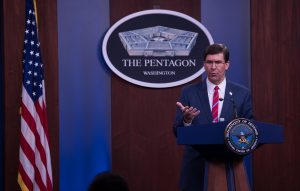On Wednesday, U.S. Secretary of Defense Mark T. Esper signed an order freezing the movement of U.S. military personnel worldwide for 60 days. The move was sparked by concerns over the spread of the coronavirus disease, or COVID–19, a global pandemic.
The U.S. order will require any deployed military personnel currently overseas to remain where they are deployed for the 60 day period, or until new guidance replaces Esper’s order. The order will also freeze upcoming deployments for U.S. military personnel in the United States that had been scheduled to go overseas.
Wednesday’s stop movement order applies to civilian personnel with the U.S. Department of Defense as well as the families of DoD personnel and servicemembers.
The U.S. military has been closely tracking the spread of COVID–19 since the disease became an apparent epidemic in the Asia-Pacific region earlier this year after its initial appearance in China.
On Tuesday, the U.S. Navy announced that three sailors on board USS Theodore Roosevelt, a Nimitz-class supercarrier, had tested positive for COVID–19 and were being airlifted off the ship. The first confirmed case on board any U.S. Navy vessel, the three cases on board Theodore Roosevelt raised concerns about possible spread aboard, where some 5,000 sailors are deployed.
The U.S. Navy, as of Tuesday, had been tracking 90 confirmed cases among its ranks. USS Theodore Roosevelt is currently in INDOPACOM’s Area of Responsibility; it visited the Vietnamese port of Da Nang earlier this month.
U.S. Chief of Naval Operations Adm. Michael Gilday said the sailors that had been airlifted were exhibited mild symptoms. “In those cases, those sailors are running a temperature and they have some body aches, but we wouldn’t necessarily characterize them as requiring hospitalization,” he said.
“But they’re positive, so we are rapidly removing them from the ship and understanding who they’ve come in contact with on the ship so we, as best we can, can try and isolate and contain,” he added.
This week, U.S. lawmakers have been deliberating a massive emergency funding relief package to stem the effect of the pandemic, which has driven much of the United States into economic lockdown.
As of Wednesday, emerging funding under deliberation by Congress included $10.5 billion for the U.S. Department of Defense. The overall relief package could amount to as much as $2 trillion and the U.S. Senate could vote as early as Wednesday evening with the House following shortly thereafter.
Some of the emergency funding slated for the Department of Defense will be earmarked for Defense Production Act spending, allowing the Pentagon to “invest in manufacturing capabilities that are key to increasing the production rate of personal protective equipment and medical equipment.”

































